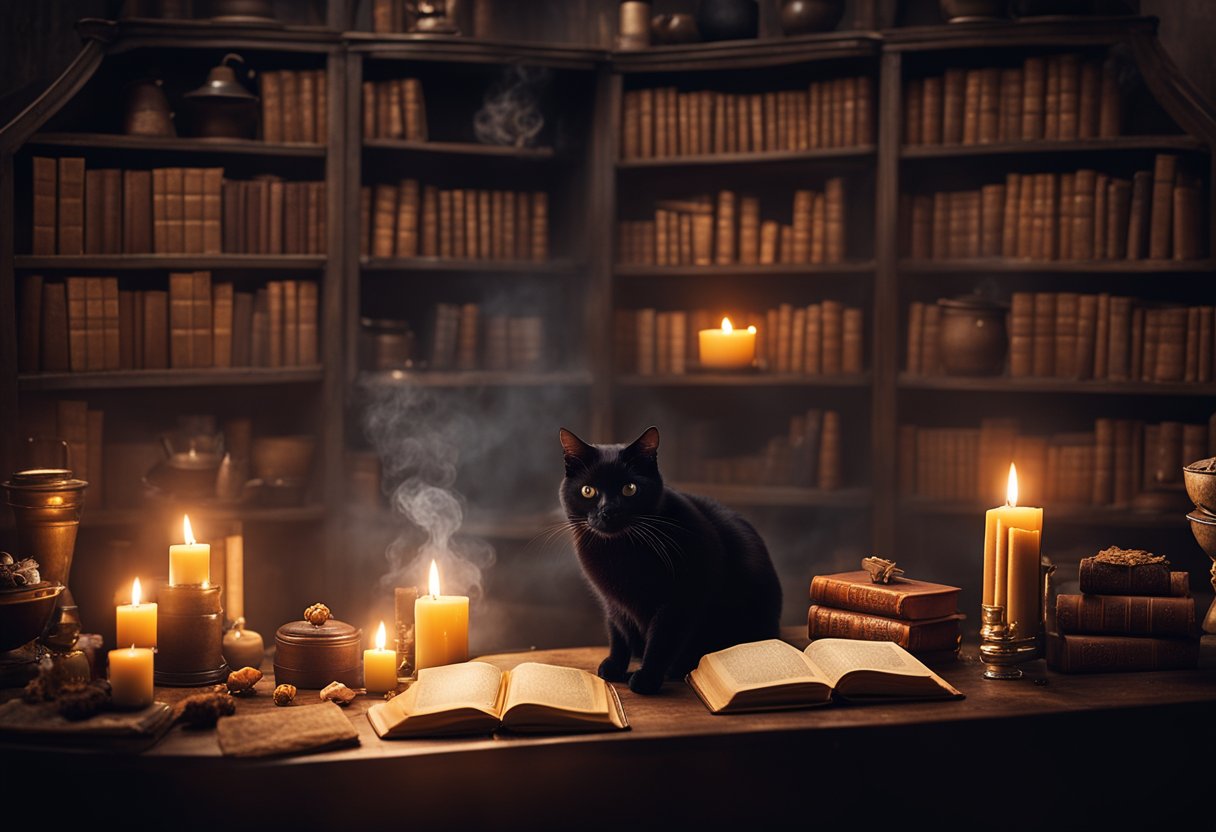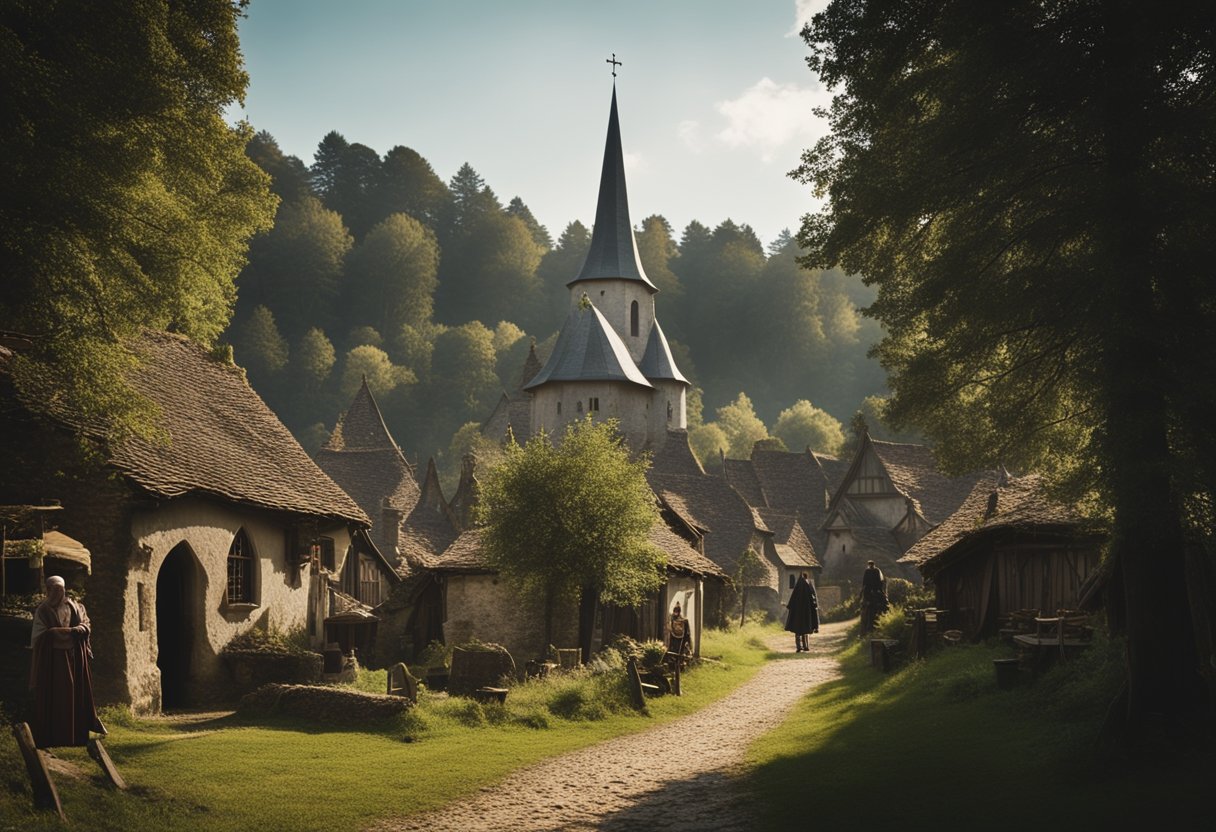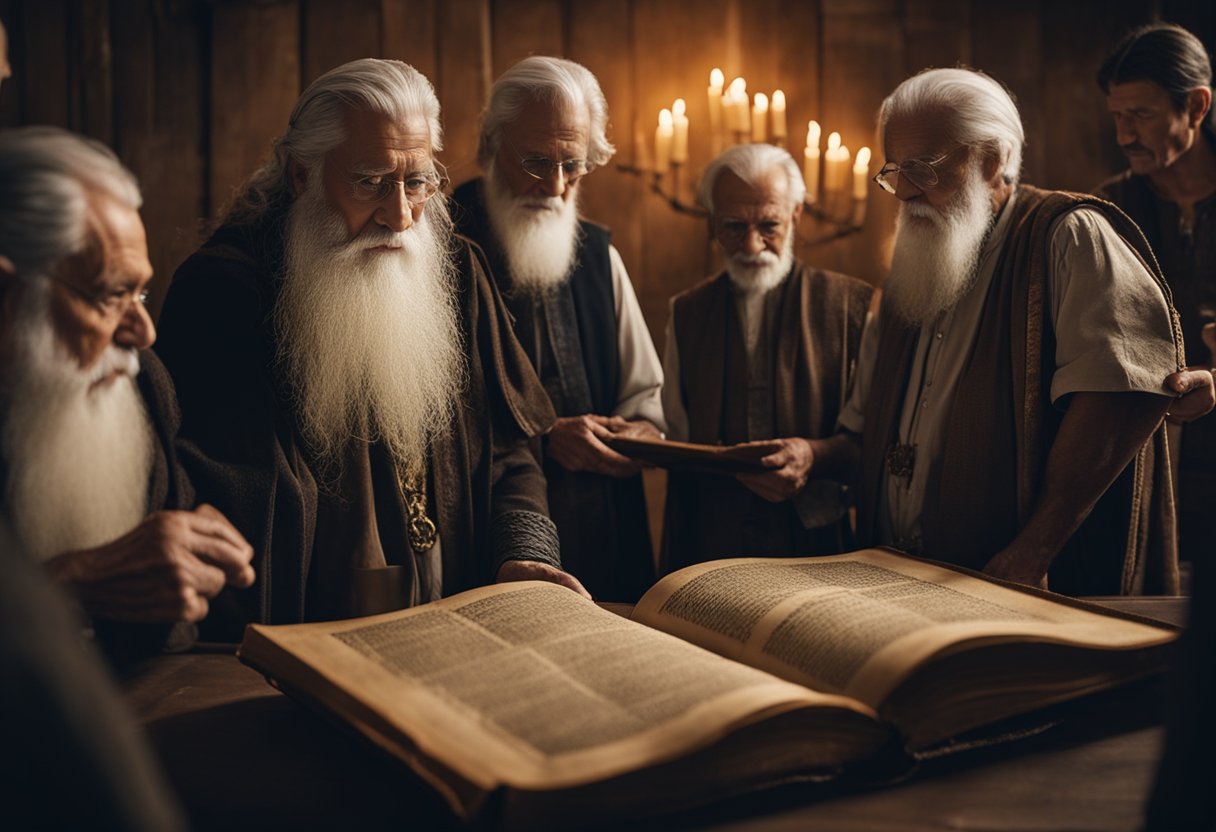Witchcraft and Wizardry: Exploring the Global Impact of Mystical Beliefs on Cultural Development

Updated On: March 20, 2024 by Eman Sameh
Witchcraft and wizardry are terms that encapsulate a myriad of beliefs and practices spread across different cultures and historical periods. They represent a significant part of folklore and religious concepts that have shaped societal norms and personal beliefs. Throughout history, these notions have held immense power, often ascribed to individuals believed to possess supernatural abilities capable of influencing the natural world. Such beliefs have led to both fascination and fear, leading to various superstitions that have seeped into cultural practices worldwide.

The impact of witchcraft and wizardry on cultures is far-reaching. Historically, they have been linked with the social dynamics of communities, reflecting the complex interplay between gender, power, and religion. For centuries, accusations of witchcraft have had dire consequences, with methods of persecution reflecting the prevailing societal fears and tensions. Conversely, contemporary views on witchcraft have evolved, revealing a nuanced understanding of its place in modern society. This duality highlights the profound influence that the supernatural beliefs attributed to witchcraft and wizardry have had on human interaction and communal development.
Historical Context of Witchcraft and Wizardry

In an era marked by superstition and fear, witch trials emerged as a means to exert control, often targeting women and attributing natural phenomena to the supernatural. This history has left a profound impact on societies worldwide.
Witch Trials in Europe
Europe’s witch trials peaked during the early modern period, especially between the 15th and 18th centuries. Our shared history is marred by tales of fear and accusation leading to the trial and often the execution of individuals, predominantly women, accused of practising witchcraft. Predicated on a belief system that witches were in league with the devil, the witch trials spread throughout Europe with infamous examples such as the Pendle Witch Trials of 1612 in England and the Salem Witch Trials of 1692 in the American colonies, which have their roots in European witch hunting traditions.
Witchcraft in Africa
In Africa, witchcraft has been viewed through a complex lens intertwined with traditional beliefs and religion. Witchcraft remains a pertinent part of many African societies, where it’s often seen as a dual force that can be either harmful or healing. Trials and accusations sometimes occur in this context, though they differ significantly from the European model. In certain regions, healers and wise women may, at the same time, be respected and viewed with suspicion, leading to a multifaceted relationship between communities and those believed to possess mystical powers.
Cultural Interpretations of Witchcraft
In this section, we explore how witchcraft has been uniquely interpreted and integrated into various cultures, touching on its significance and the profound impacts it has had on societies globally.
Cultural Significance
Witchcraft has a long-standing presence in many cultures, often intertwined with religion and deeply rooted superstitional beliefs. In African societies, for instance, witchcraft is traditionally seen as a potent force, with individuals known as witches believed to harness supernatural powers. This cultural understanding links the every day with the spiritual, attributing both good and bad fortunes to the actions of these individuals. Witchcraft beliefs around the world are diverse, but many cultures hold a common belief in the ability of witches to affect change through means beyond the physical world.
Christianity’s influence has historically painted witchcraft as a malevolent practice, often associating it with the devil and condemning it as heresy. These cultural interpretations have prompted various witch-hunts, especially in medieval Europe, where fear and misunderstanding led to tragedy.
Societal Impact
The societal impact of witchcraft beliefs can be profound and far-reaching. In some societies, individuals accused of sorcery or witchcraft have faced severe consequences, including social stigma, violence, or even death. The fear engendered by witchcraft accusations has been a compelling force, shaping communities and motivating social control measures. Witchcraft in Nigerian culture highlights how deeply embedded such beliefs are and the dramatic repercussions accusations can have.
Beliefs in spirits and the supernatural have also fostered a sense of community and offered explanations for inexplicable events, cementing social bonds in the face of adversity. These shared beliefs have provided solace and a framework for understanding the world around us, reaffirming the cultural fabric of many societies.
The Role of Gender and Power
In this section, we explore the intersection of gender and power dynamics within the context of witchcraft and how they have influenced societal structures and perceptions.
Witches and Women
Women were frequently at the centre of witchcraft accusations, often targeted due to their gender and associated with both evil and good forms of power. This persecution was rooted in fear and the notion that women who did not conform to societal norms or who were seen as too powerful or independent were often labelled as witches. Historical analysis reveals that beliefs in witchcraft have been documented globally, with a particular focus on the ability to cause harm through supernatural means.
Power Dynamics
Within the arena of witchcraft, power dynamics played a crucial role. Those in positions of authority utilised accusations of witchcraft as a means to exert control, particularly over women. The gendered nature of these beliefs sheds light on the challenges faced by historians in dissecting the complex interplay between societal expectations, gender roles, and the dynamics of power.
Religious Influences on Witchcraft Perceptions

In examining the perceptions of witchcraft, it’s evident that religious viewpoints have profoundly shaped these beliefs, which range from the interpretations of sacred texts to traditional folklore.
Christian Views
Christianity has historically viewed witchcraft through the lens of its sacred text, the Bible, which contains explicit references that have shaped Christian attitudes towards witchcraft practices. Biblical passages, particularly from the Old Testament, such as “Thou shalt not suffer a witch to live” (Exodus 22:18), cemented a stance against witchcraft. This view was amplified during periods such as the European witch trials, where the fear of witches and their association with Satan influenced widespread persecution.
The New Testament also contributed to this perception by mentioning spiritual warfare and the battle against evil spirits, which many interpreted as a condemnation of witchcraft. As such, beliefs in witchcraft were often intertwined with the Christian belief in Christ as the saviour against such evils.
Pagan and Other Beliefs
Contrastingly, Pagan religions and various other spiritual traditions around the world have often embraced what might be classified as witchcraft in a positive light. Many such beliefs are rooted in ancient folklore and an affinity with natural forces, which differ greatly from Christian views.
Pagan systems, comprising a diverse array of beliefs, typically do not acknowledge the Christian concept of Satan but instead have their own pantheons and spiritual entities. The practices that Christianity might label as ‘witchcraft’, Pagan traditions may be seen as natural magic, a way to work in harmony with the elements and spiritual forces.
In these traditions, the concept of ‘harm none’ is frequently a core tenet, and the practitioners may refer to themselves as witches, with the term carrying positive connotations of wisdom and connection with nature. However, within these different belief systems, we also find divergences in how witchcraft is perceived and practised.
Witchcraft beliefs can thus be seen through a spectrum of religious influences, from god-fearing opposition in some Christian communities to an embraced element of spirituality in Pagan and other beliefs.
The Psychology Behind Witchcraft Accusations
In exploring the psychological underpinnings of witchcraft accusations, we uncover a complex interplay of fear and the need for community control.
Fear and Scapegoating
Witchcraft accusations often surge during social unrest or misfortune, serving as a conduit for collective anxiety. In times of crisis, communities may seek to locate and cast out a scapegoat—often in the form of alleged witches. This process not only provides a tangible target for the community’s fears but also a sense of control in uncertain times. For instance, accusations may arise in response to unexplainable misfortunes such as crop failures or sudden deaths, which amplify the innate dread of the unknown and create an urgent need to restore order.
Psychological Control
Beyond fear, witchcraft accusations play a significant role in the enforcement of social norms and the establishment of psychological control. Historically, those with nonconforming beliefs or behaviours have been susceptible to such accusations. This serves as a potent warning to others to adhere to the accepted standards of the community. By instilling a fear of persecution, authority figures or fervent believers leverage witchcraft accusations to maintain conformity and discourage dissent within the community.
In both instances, psychology intertwines with the darker aspects of human nature. While faith in supernatural forces is a feature of many cultures worldwide, the stigmatisation of witchcraft and the resulting accusations narrate a cautionary tale of how fear and the desire for social cohesion can culminate in acts of profound injustice.
Methods of Identifying and Persecuting Witches
In historical contexts, methods to identify and persecute witches were both complex and harrowing, largely driven by superstition and fear. These approaches varied by region, but they were united by the shared goal of rooting out those accused of witchcraft.
Trials and Evidence
Witch trials often operated on the presumption of guilt, and the accused faced a severe risk of execution if convicted. Trials could be sparked by as little as a neighbour’s accusation or any unfortunate event lacking explanation. Evidence was not required to meet any modern standard of proof, and it could include testimony or the identification of a physical trait considered to be a witch’s mark.
- Swimming Test: Accused witches were bound and cast into the water to see if they would sink or float, with those floating deemed guilty.
- Pricking and Scratching: Suspects were pricked with needles and blades; an absence of bleeding or pain was seen as proof of witchcraft.
- Spectral Evidence: Witnesses might claim to see a manifestation of a witch’s spirit or spectre, which was accepted as evidence.
These methods not only put innocent people at risk but also created a widespread culture of fear and suspicion.
Torture and Confession
Torture was a horrific reality for many accused witches, as it was believed to be an effective means to gain a confession. Under extreme duress, individuals would admit to outlandish claims and name others as accomplices, leading to a cascade of accusations.
- The Strappado: Suspects were hung from the ceiling by their wrists, which were tied behind their backs, and weights were added to their ankles.
- Thumbikins: Small crushing devices were applied to fingers and thumbs to elicit confessions through pain.
The use of torture generated numerous false confessions, further perpetuating the cycle of persecution and execution of alleged witches. With confessions obtained, the accused were often executed, typified by methods such as hanging or burning at the stake.
The Impact of Witchcraft on Individuals and Communities
Exploring the realm of witchcraft offers insight into how these beliefs have historically shaped societies and affected individuals on personal and communal levels.
Social and Economic Effects
Witchcraft has played a complex role in social dynamics and economic structures across the world. In some societies, the fear of witchcraft leads to social cohesion, driving individuals to adhere to societal norms for fear of being labelled as witches. This often results in self-governance within communities. However, accusations of witchcraft can also have detrimental effects, such as ostracism or persecution of the accused, disturbing social harmony. Economically, witchcraft accusations can lead to the confiscation of property or the disruption of local markets, especially if individuals or groups deemed to be witches are excluded from economic activities. Exploratory analysis of witchcraft beliefs has highlighted the multi-faceted impact such beliefs have on the communities that hold them.
Health and Misfortune
The entanglement of witchcraft with concepts of health and misfortune often sees individuals attributing unexplained illnesses or unfortunate events to supernatural causes. This can impact healthcare choices, as some may seek traditional healing practices instead of medical treatment. In matters of fertility, witchcraft is sometimes blamed for unexplained infertility, leading to stigmatisation and strained relations within families. Notably, the psychological burden and stress caused by the fear of witchcraft or accusations can have real health implications, ranging from anxiety to psychosomatic symptoms. Studies have documented the highly variable nature of witchcraft beliefs and their consequences around the world.
Rituals and Practices
Witchcraft and wizardry have long been accompanied by various rituals and practices with significant cultural and mystical weight. Our focus narrows on two pivotal elements: the casting of spells and the crafting of magical items.
Magic and Spells
Magic, in the realm of witchcraft, is the art of influencing or predicting natural events through mystical, supernatural means. Spells are the essential components of magic – structured words or incantations aimed at achieving specific effects. The practice often depends on the time of day, phase of the moon, and availability of materials believed to carry magical properties. Across cultures, a spell can be a chant, a written verse, or an intricate ritual performed with the intention of bringing about a particular outcome. In many traditions, spells are thought to connect the physical world with the unseen forces that bind the universe.
Amulets and Potions
Protection and healing are the primary purposes of both amulets and potions in witchcraft. Amulets are objects, often jewelled or inscribed, which are considered to possess the power to protect the bearer from harm and evil influences or to bring good luck. They often require consecration through a ritual to activate their magical attributes. On the other hand, potions are liquid concoctions brewed with various ingredients, each chosen for their alchemical properties, and are frequently utilised to heal, induce love, or even act as poisons. The creation of a potion is a delicate art, often requiring knowledge of herbology and precise timing in its preparation.
Contemporary Witchcraft
In this section, we’ll uncover the current practice and perception of witchcraft, focusing on its modern interpretations and the burgeoning movement of Wicca, which has weaved its way into today’s cultural fabric.
Modern Interpretations and Movements
Witchcraft in the contemporary age is often seen through the lens of pop culture, yet it goes beyond mere entertainment to reflect a reality of practising individuals and groups. No longer confined to the shadows, the occult is gaining ground as an institutional presence with education systems offering courses on modern mysticism and esoteric traditions. This has led to a transformation of witchcraft’s image, shedding some of its historical stigmas and becoming more integrated into everyday life.
Wicca and Neopaganism
Wicca is a prominent strand of Neopaganism that celebrates nature and the changing seasons. It’s deeply rooted in ritual and often misunderstood as old-world witchcraft. However, Wicca is a recognised religion, with organised groups and solitary practitioners who engage in ceremonies aligning with the natural world. Our education on Wicca reveals a structured belief system with its own set of ethics, often highlighting the importance of environmental protection within a contemporary pagan framework.
Legislation and Protection Against Witchcraft Accusations

In response to the harrowing precedence of witch-hunt atrocities, a significant legal pivot has been made towards scrutinising and revising relevant legislation. This ensures better human rights safeguards for those accused.
Legal Framework
Chronicles of Witchcraft Legislation: The legal system has been a pivotal force in both perpetuating and curbing witchcraft accusations. Historically, laws targeting witchcraft have been documented as far back as the fifteenth century, primarily as a judicial reaction to village rumours and suspicions, escalating to severe witch hunts. Contemporary legal approaches have taken a more protective stance against such accusations. Notable instances have seen legislation aimed at eliminating the malicious practice of witchcraft accusations, fostering a safeguarded environment for the accused.
Efforts to legally shield individuals from fallacious witchcraft claims are evident in United Nations resolutions, which call for the abolition of accusatory practices underpinned by superstitions. This has resulted in the crafting of guidelines towards eliminating human rights abuses tied to witchcraft and ritual attacks.
Human Rights Perspectives
The Global Human Rights Discourse: Witchcraft allegations, steeped in superstition and fear, have transcended eras and continents, often infringing upon the fundamental human rights of the accused. In the recent global landscape, pivotal movements by human rights entities have shaped a directive forbidding victimisation based on witchcraft claims.
The discussion envelops the need for protection of the vulnerable—often women, children, the elderly, and persons with disabilities, including those with albinism. Increasingly, human rights perspectives have informed policy, urging for the eradication of discrimination and violence stemming from accusations of witchcraft or sorcery, as outlined in articles examining this intricate part of human rights.
Our collective progress in this endeavour is tied to the recognition and enforcement of these rights, embracing the legal frameworks that support the innocent and press against culturally ingrained prejudices.
Frequently Asked Questions
In delving into the intricate weave of witchcraft and wizardry, we uncover a tapestry of cultural beliefs and practices that have shaped and coloured the human experience throughout our shared history. Our exploration promises insights into how these beliefs continue to influence societies across the world.
What are some common superstitions and their origins from various cultures worldwide?
Around the globe, superstitions have taken root in the cultural soil with diverse origins. In the northeastern United States, for example, so-called witch windows are installed at an angle, believed to protect homes from witches flying on broomsticks.
How have superstitions influenced different aspects of society throughout history?
Throughout history, superstitions have informed everything from architecture to healthcare practices, with an especially marked impact during times of uncertainty and turmoil. Superstitious practices have even led to the persecution of alleged witches, a dark reminder of the potent effects of fear on societal behaviour.
In what ways do superstitious beliefs impact individual behaviour and community interactions?
Superstitious beliefs often serve as unwritten laws governing individual and community conduct. Anthropological studies have documented that accusations of witchcraft can stem from social tensions, reiterating the influence of such beliefs on community interactions.
Can superstitions have tangible effects on people’s health, and if so, how?
Yes, superstitions can manifest in tangible health outcomes. For instance, the placebo effect is a well-documented phenomenon where positive health effects arise from the mere belief in a treatment’s efficacy. Conversely, the nocebo effect, related to harmful beliefs, can cause actual health detriments.
What role do superstitious beliefs play in the cultural identity and traditions of a community?
Superstitions often become interwoven with a community’s cultural identity and traditions, sometimes embodied in rituals, folklore, and annual celebrations. They contribute to the community’s unique heritage and can offer a sense of continuity and connection to the past.
What are examples of superstitions that are still prevalent in modern societies?
Many modern societies still hold superstitions. For example, a global analysis reveals varied levels of belief in witchcraft, with rates ranging from 9% in Sweden to 90% in Tunisia. This underscores the enduring presence and relevance of these superstitions across contemporary cultures.






